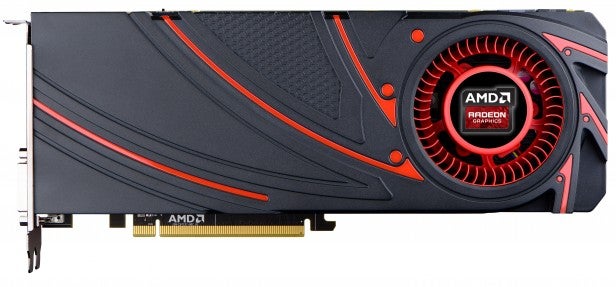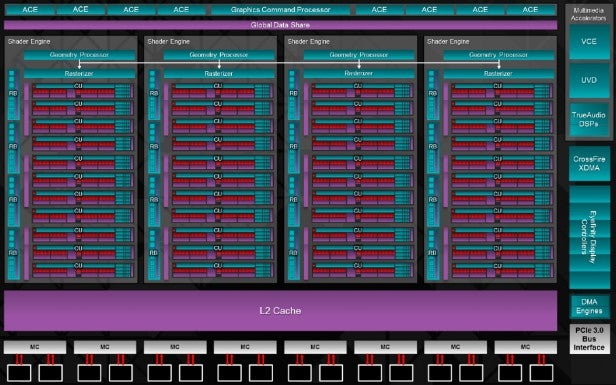AMD Radeon R9 290 Review
AMD Radeon R9 290
A solid performer for 1080p and 1440p gaming but power hungry

Sections
- Page 1 AMD Radeon R9 290 Review
- Page 2 AMD Radeon R9 290 – Test Results Review
- Page 3 AMD Radeon R9 290 – Performance Analysis and Verdict Review
Verdict
Pros
- Solid 1080p and 1440p performance
- Cheaper than GTX 970
- Good free games offer
Cons
- GTX 970 is consistently quicker
- Hotter and more power hungry than Nvidia card
Key Specifications
- Review Price: £221.00
- 947MHz core clock
- 1,250MHz 4GB GDDR5 memory
- 6.2 billion transistors
- 2,560 stream processors
- requires 1 x 8-pin and 1 x 6-pin power connector
What is the AMD Radeon R9 290?
This may be one of AMD’s most recent high-end GPUs, but it’s based on the Graphics Core Next architecture that’s been in use since way back in 2011. That might make the R9 290 sound long in the tooth, but it makes sense: AMD has refined its hardware to make gains in every new generation, and the reliance on reliable, existing silicon means it can continue to support existing technologies.
This latest card is a bit of a throwback when it comes to power consumption but its performance is good for the price.
Under the Hood
The Hawaii GPU used to build the R9 290 is 24% larger than the HD 7970 that it replaces, and its 6.2 billlion transistors easily outweigh the 5.2 billion installed inside the Nvidia GeForce GTX 970 – the Radeon’s biggest rival. Elsewhere, architectural changes mean the new core can handle more tasks at once, with graphics and compute tasks able to be handled simultaneously.
SEE ALSO: AMD R9 290 vs Nvidia GTX 970

The R9 290 shares its underlying core with the £275 R9 290X but, to build the cheaper of the two cards, AMD has deactivated some of its stream processors. This card has 2,560 processors organised into 40 compute units rather than the 2,816 processors and 44 units installed into AMD’s current flagship single-GPU card. The R9 290’s core clock of 947MHz is below the GTX 970’s 1,050MHz speed.
That’s still an impressive amount of hardware, and it’s paired with 4GB of GDDR5 – the same amount on paper as the GTX 970. And, unlike Nvidia’s card, the R9 290 can make use of all of that memory when it’s playing top-end games. It’s clocked to 1,250MHz, which is a little slower than the Nvidia card, but it’s accessed using a 512-bit bus – much wider than Nvidia’s 224-bit equivalent.
The big, transistor-filled core and generous memory bus mean that the R9 290’s theoretical output figures are impressive. Its 4.84 TFLOP GPU output beats the GTX 970’s 3.49 TFLOP figure, and its total memory bandwidth of 320GB/s is also far higher.
The older architecture does mean that AMD’s card won’t be as efficient as its competition from Nvidia. That will cause issues for the card when it comes to heat and power consumption, but it’s also manifested in a more practical way: this card requires six- and eight-pin power connectors, while the GTX 970 needs just two six-pin plugs.

How We Tested
We’ve fired up five games for this GPU test. Battlefield 4, Bioshock Infinite, Crysis 3, Metro: Last Light and Batman: Arkham Origins all get a run through. We’ve tested at 1,920 x 1,080, 2,560 x 1,440 and even 3,840 x 2,160 to see which card is best across single-screens – and to check if any of them can handle 4K.
We’ve used 3D Mark’s Fire Strike test and four Unigine Heaven benchmarks to test theoretical performance, and we’ve taken idle and load temperatures and power requirements to see which card is the coolest and most frugal.
Our test rig consists of an Asus X79-Deluxe motherboard, Intel Core i7-4960X processor, 16GB of RAM and a 1TB hard disk.
To get prices for each card we visited www.scan.co.uk and noted down the cheapest stock-speed card we could find, although we will be referring to the various overclocked and tweaked models available for each GPU, which will be more expensive, later on in the review.


